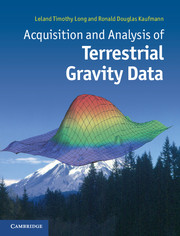Book contents
- Frontmatter
- Contents
- Preface
- 1 Gravitational attraction
- 2 Instruments and data reduction
- 3 Field acquisition of gravity data
- 4 Graphical representation of the anomalous field
- 5 Manipulation of the gravity field
- 6 Interpretation of density structure
- 7 The inversion of gravity data
- 8 Experimental isostasy
- A Appendix ACommon definitions and equations in potential theory
- B Appendix BGlossary of symbols
- References
- Index
6 - Interpretation of density structure
Published online by Cambridge University Press: 05 February 2013
- Frontmatter
- Contents
- Preface
- 1 Gravitational attraction
- 2 Instruments and data reduction
- 3 Field acquisition of gravity data
- 4 Graphical representation of the anomalous field
- 5 Manipulation of the gravity field
- 6 Interpretation of density structure
- 7 The inversion of gravity data
- 8 Experimental isostasy
- A Appendix ACommon definitions and equations in potential theory
- B Appendix BGlossary of symbols
- References
- Index
Summary
Introduction
The density distribution required to generate a gravity anomaly is non-unique. While a density distribution generates a unique anomaly, there are many density distributions that can generate that same anomaly. Hence, gravity anomalies alone cannot determine the distribution of densities. However, because the gravity field is generated by a distribution of single poles of attraction, it is generally simpler to interpret than dipole fields like the magnetic field. The non-uniqueness of the potential field prevents one from obtaining an unconstrained solution for the density structure. The only parameter that can be defined from noise-free data is the maximum depth to some part of the structure, and that useful information is itself based on the assumption that part of the anomaly is equivalent to a point mass. Also, if the gravity anomaly is well defined, the excess or missing mass can be computed directly from the gravity data, although the distribution of that mass in the subsurface cannot be defined. The non-uniqueness of the potential field can only be overcome by assuming that the structure fits some pre-conceived understanding concerning its density, shape, and position.
In finding a density model for a gravity anomaly the details of the assumptions will influence and often determine the solution. In effect, any solution that satisfies the restriction concerning the maximum depth to the top of the structure will be determined principally by the assumptions concerning the nature and shape of the density structure. The most common assumptions are based on well-understood shapes for geologic structures. Assumptions appropriate for a flat and shallow sedimentary basin differ greatly from those appropriate for the thin vertical plane of an intrusive dike, and the gravity anomalies would also have significantly different shapes. On the other hand, a sphere at depth might duplicate the approximate shape of an anomaly from a symmetrical shallow basin, but such a model would be an unrealistic solution where the surface geology clearly shows the existence of a basin. An obvious constraint on any model is that the modeled structure should not extend above the surface, a contradiction often created with the application of models that are too simple.
- Type
- Chapter
- Information
- Acquisition and Analysis of Terrestrial Gravity Data , pp. 99 - 128Publisher: Cambridge University PressPrint publication year: 2013



